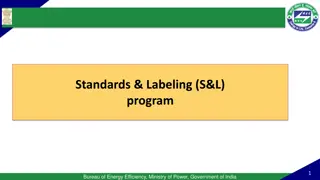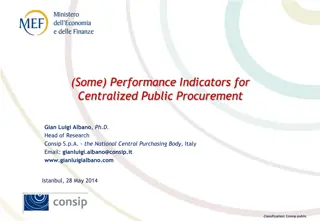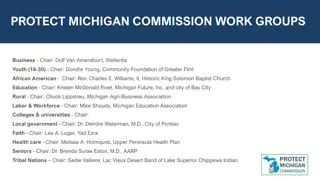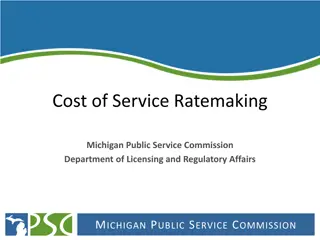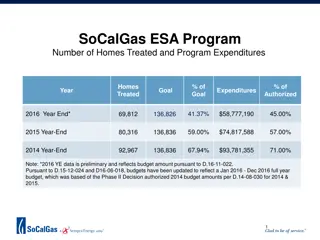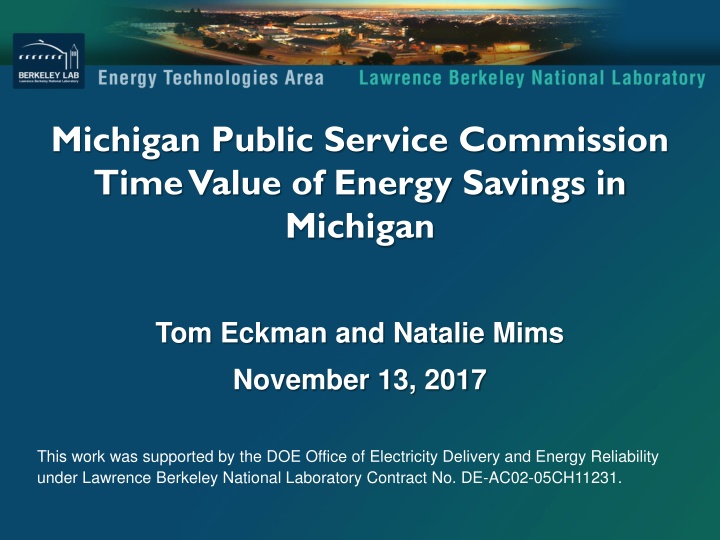
Michigan Public Service Commission Time Value of Energy Savings
This work by Tom Eckman and Natalie Mims, supported by the DOE, explores the time-varying energy and demand impacts of measures in Michigan. It delves into topics such as residential lighting, water heating, air conditioning, and commercial lighting. The study compares Michigan's results with other locations and details the methodology used to calculate energy savings and capacity values.
Download Presentation

Please find below an Image/Link to download the presentation.
The content on the website is provided AS IS for your information and personal use only. It may not be sold, licensed, or shared on other websites without obtaining consent from the author. If you encounter any issues during the download, it is possible that the publisher has removed the file from their server.
You are allowed to download the files provided on this website for personal or commercial use, subject to the condition that they are used lawfully. All files are the property of their respective owners.
The content on the website is provided AS IS for your information and personal use only. It may not be sold, licensed, or shared on other websites without obtaining consent from the author.
E N D
Presentation Transcript
Michigan Public Service Commission Time Value of Energy Savings in Michigan Tom Eckman and Natalie Mims November 13, 2017 This work was supported by the DOE Office of Electricity Delivery and Energy Reliability under Lawrence Berkeley National Laboratory Contract No. DE-AC02-05CH11231.
Thanks To: Consumers Energy Staff DTE Staff & Rick Morgan For Your Assistance and Patience 2
Study Approach Document time-varying energy (TVE) and demand impacts of 5 measures in Michigan Exit sign (flat load shape) Residential Lighting Residential Water Heating Residential Central Air Conditioning Commercial Lighting Use publicly available avoided costs and a combination of hourly avoided energy cost and coincidence factors (CF) derived from: DSMore hourly load shapes and CFs derived from DSMore DSMore hourly load shapes with CFs derived from Michigan Energy Measures Database (MEMD) Hourly load shapes from metered data from PNW or building simulation modeling Compare Michigan TVE results to other four locations in prior study 3
General Methodology Average Consumers Energy and DTE system load shapes from 2014- 2016 to represent Michigan hourly load shape to determine system peak Use DSMore hourly energy load shapes and 15 year forecast of hourly avoided energy cost to calculate value of energy (kWh) savings Use coincidence factors (CF) from Michigan Energy Measures Database and avoided generation capacity, transmission and distribution deferrals and ancillary services to calculate capacity (kW) value of energy savings Use hourly load shapes from Pacific Northwest metering research to derive energy and capacity value for three end uses, Residential Lighting and Water Heating and Commercial Lighting Use Building America simulation model hourly load shapes to derive energy and capacity value for residential air conditioning 4
Input: Annual System Load Shapes 100% 90% 80% Percent of Peak Month Load 70% 60% Pacific Northwest 50% California 40% Massachusetts Georgia 30% CE/DTE 20% 10% 0% Jan Feb Mar Apr May Jun Jul Aug Sep Oct Nov Dec 5
Input: CE/DTE Typical Summer Day System Load Shape and DSMore End-Use Load Shapes 100% 90% 80% Percent of Peak Hour Load 70% 60% 50% 40% 30% 20% 10% 0% 1 2 3 4 5 6 7 8 9 10 11 12 13 14 15 16 17 18 19 20 21 22 23 24 Michigan CE/DTE ResLight ResCAC & ResDHW CommLight Exit Sign 6
Input: CE/DTE Typical Winter Day System Load Shape and DSMore End-Use Load Shapes 100% 90% 80% Percent of Peak Hour Load 70% 60% 50% 40% 30% 20% 10% 0% 1 2 3 4 5 6 7 8 9 10 11 12 13 14 15 16 17 18 19 20 21 22 23 24 Michigan CE/DTE ResLight ResDHW CommLight Exit Sign 7
Inputs: Avoided Cost Input Assumption Value Real Discount Rate* 3.88% Expected Measure Life 15 years Annual Savings (Normalized for all measures) 1000 kWh/yr. (1 MWh) System Losses 7.08% Levelized Avoided Energy Cost Varies by load shape Levelized Avoided Capacity Cost (2016$) $71.50 /kW-yr. Levelized Avoided Transmission and Distribution Cost (2016$) $80 /kW-yr. Levelized Avoided Ancillary Service Cost (2016$) $3.34 /kW-yr. Avoided CO2 Cost Avoided Renewable Portfolio Standard Cost $0 $0 Avoided Demand Reduction Induced Price Effect (DRIPE) $0 Avoided Risk $0 8
Inputs: Coincident Peak Capacity Reduction Michigan Energy Measures Data Base (MEMD) PNW Metered Maximum Non- Coincident Demand (MW) Maximum Non- Coincident Demand (MW) Coincident Peak Load Reduction (MW/MWh) Coincident Peak Load Reduction (MW/MWh) Coincidence Factor Coincidence Factor End Use Residential Lighting Residential Water Heating 0.10 0.98 0.098 0.25 0.31 0.08 0.71 0.25 0.178 0.21 0.40 0.08 Exit Sign (Flat) 1.00 0.12 0.122 1.00 0.12 0.12 9
Inputs: Coincident Peak Capacity Reduction Michigan Energy Measures Data Base (MEMD) Maximum Non- Coincident Demand (MW) PNW Metered* Maximum Non- Coincident Demand (MW) Coincident Peak Load Reduction (MW/MWh) Coincident Peak Load Reduction (MW/MWh) Coincidence Factor Coincidence Factor End Use Residential Central Air Conditioning Residential Central Air Conditioning - Lansing Residential Central Air Conditioning - Detroit 0.72 0.75 0.543 0.49 7.28 3.59 0.53 4.41 2.35 Residential Central Air Conditioning - RBSA 0.36 2.29 0.83 Residential Central Air Conditioning - ELCAP 0.48 2.91 1.40 Commercial Office Lighting 0.49 0.37 0.180 Commercial Office Lighting - CEC 0.76 0.29 0.22 Commercial Office Lighting - ELCAP 0.52 0.28 0.14 *Residential CAC for Lansing and Detroit derived from Building America building simulations 10
DSMore Typical Summer Day Load Shapes Compared to Metered Residential Water Heating End-Use Load Shapes 100% 90% 80% Percent of Peak Hour Load 70% 60% 50% 40% 30% 20% 10% 0% 1 2 3 4 5 6 7 8 9 10 11 12 13 14 15 16 17 18 19 20 21 22 23 24 Metered-PNW DSMore 11
DSMore Typical Summer Day Load Shapes Compared to Metered Residential Lighting End-Use Load Shapes 100% 90% 80% Percent of Peak Hour Load 70% 60% 50% 40% 30% 20% 10% 0% 1 2 3 4 5 6 7 8 9 10 11 12 13 14 15 16 17 18 19 20 21 22 23 24 Metered-PNW DSMore 12
DSMore Typical Summer Day Load Shapes Compared to Metered Commercial Lighting End-Use Load Shapes 100% 90% 80% Percent of Peak Hour Load 70% 60% 50% 40% 30% 20% 10% 0% 1 2 3 4 5 6 7 8 9 10 11 12 13 14 15 16 17 18 19 20 21 22 23 24 Metered-PNW DSMore 13
DSMore Typical Summer Day Load Shapes Compared to Simulated Residential Central AC End-Use Load Shapes 100% 90% 80% Percent of Peak Hour Load 70% 60% 50% 40% 30% 20% 10% 0% 1 2 3 4 5 6 7 8 9 10 11 12 13 14 15 16 17 18 19 20 21 22 23 24 DSMore Grand Rapids - Simulated PNW-RBSA (Metered) Detroit-Simulated Traverse City - Simulated PNW-ELCAP (Metered) Lansing-Simulated Sault Ste Marie - Simulated 14
Results: Total Utility System Value of Savings Compared to Only Their Energy Value 3.5 Northwest Ratio of Total Value to Energy Value 3.0 California Massachusetts 2.5 CE/DTE w/DSMore & MEMD CFs CE/DTE w/PNW Metered 2.0 1.5 1.0 0.5 - Flat/Uniform Across All Hours Residential Water Heating Residential Central Air Conditioning Residential Lighting Commercial Lighting Notes: The flat load shape is an exit sign. Energy value includes: energy, risk, carbon dioxide emissions, avoided RPS and DRIPE, as applicable. Total time-varying value includes all energy values and capacity, transmission, distribution and spinning reserves. Ratios are calculated by dividing total time-varying values by energy-only values. 15
Results: Total Value DSMore Load Shapes and MEMD Coincidence Factors $250 Distribution Levelized Total Utility System Value Transmission $200 Generating Capacity (2016$/MWh) DRIPE $150 Avoided RPS $100 CO2 Risk $50 Reserves/Ancillary Services Energy $0 Flat ResDHW Res CAC ResLight ComLight Note: Avoided Transmission cost also include avoided cost of distribution 16
Results: Total Value Metered Load Shapes and Coincidence Factors $300 Distribution Levelized Total Utility System Value Transmission $250 Generating Capacity DRIPE $200 (2016$/MWh) Avoided RPS $150 CO2 Risk $100 Reserves/Ancillary Services Energy $50 $0 Flat ResDHW Res CAC- PNW ResLight ComLight Note: Avoided Transmission cost also include avoided cost of distribution 17
Why Accurate Load Shapes Matter Example: When DSMore and Metered Commercial End-Use Load Shapes Agree, Both Produce Equivalent Values for Annual Energy Savings 100% Levelized Value of Annual Energy Savings Using Metered Load Shape = $62/MWh 90% 80% Percent of Peak Hour Load 70% 60% 50% Levelized Value of Annual Energy Savings Using DSMore Load Shape = $61/MWh 40% 30% 20% 10% 0% 1 2 3 4 5 6 7 8 9 10 11 12 13 14 15 16 17 18 19 20 21 22 23 24 DSMore Metered-PNW 18
Why Accurate Load Shapes Matter When DSMore and Metered Load Shapes Residential Lighting Disagree, They Produce Significantly Different Values for Annual Energy Savings 100% DSMore Load Shape Levelized Value of Annual Energy Savings = $75/MWh 90% Percent of Annual Peak Hourly Load 80% Annual Average Daily Load Shape 70% 60% 50% 40% Metered Load Shape Levelized Value of Annual Energy Savings = $56/MWh 30% 20% 10% 0% 1 2 3 4 5 6 7 8 9 10 11 12 13 14 15 16 17 18 19 20 21 22 23 24 Metered DSMore 19
Why Accurate Load Shapes Matter When DSMore and Metered Load Shapes Residential Air Conditioning Disagree, They Produce Significantly Different Values for Annual Energy Savings 100% DSMore Load Shape Levelized Value of Annual Energy Savings = $108/MWh 90% Percent of Annual Peak Hourly Load 80% Annual Average Daily Load Shape 70% 60% 50% 40% Metered Load Shape Levelized Value of Annual Energy Savings = $127/MWh 30% 20% 10% 0% 1 2 3 4 5 6 7 8 9 10 11 12 13 14 15 16 17 18 19 20 21 22 23 24 DSMore Metered 20
Why Accurate Load Shapes Matter Example: Valuing Residential Lighting Annual Energy Savings $100 Non-Metered Load Shapes May Overstate Energy Value Distribution $90 Levelized Total Utility System Value Transmission $80 Generating Capacity $70 (2016$/MWh) DRIPE $60 Avoided RPS $50 $40 CO2 $30 Risk $20 Reserves/Ancillary Services $10 Energy $0 DSMore w/MEMD CF Metered 21
Why Accurate Load Shapes Matter Example - Valuing Residential Central AC Capacity Savings $600 Distribution Levelized Total Utility System Value $500 Transmission Simulated load shape overstates peak demand impact due to lack of diversity Generating Capacity $400 (2016$/MWh) DRIPE $300 Avoided RPS CO2 $200 Risk $100 Reserves/Ancillary Services Energy $0 DSMore w/MEMD CFs PNW RBSA Metered Detroit-Simulated 22
Observations The ratio of the total utility system value of energy savings to their energy value in Michigan align reasonably well with other states with similar system load shapes However, the lack of publicly available and statistically representative metered end use load shape data for Michigan limits the ability to confidently characterize the time differentiated value of energy efficiency savings, especially for weather sensitive measures such as central air conditioning 23
Observations Load Shape data embedded in DSMore may not accurately represent the hourly distribution of energy use for some end uses Coincidence Factors drawn from the Michigan Energy Measures Data Base (MEMD) differ from those derived from metered end use data for three of the five end uses considered in this study This does not necessarily mean that they are inaccurate Load Shape data derived from simulations, while reflecting weather sensitivity, may not accurately represent the hourly distribution of energy use unless they can reflect diversity of occupant behavior 24
Tom Eckman teckman49@gmail.com 503-803-5047 Natalie Mims namims@lbl.gov 510-486-7584 Lisa Schwartz lcschwartz@lbl.gov 510-486-6315 Visit our website at: http://emp.lbl.gov/ Click here to join the LBNL Electricity Markets and Policy Group mailing list and stay up to date on our publications, webinars and other events. Follow the Electricity Markets & Policy Group on Twitter @BerkeleyLabEMP







